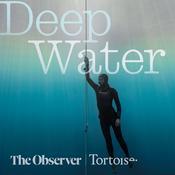Available Episodes
5 of 111
- New Week #133Welcome to this update from New World Same Humans, a newsletter on trends, technology, and society by David Mattin.If you’re reading this and haven’t yet subscribed, join 25,000+ curious souls on a journey to build a better future 🚀🔮For this week’s instalment, I’m doing something different.A few days ago I recorded a video update to share some thoughts on OpenAI’s new GPT-4o and the state of AI.It went first to Exponentialist subscribers. But I want to share it with you all, too.In the video I get into: * Why GPT-4o is OpenAI’s play for billions of users, and for a virtual companion that weaves itself through the fabric of everyday life* Where we are inside the amazing AI moment we’re living through, and what’s coming next, including a path to AGI* How this all connects to the Great Enweirdening of the economy that I believe is comingThere’s so much happening with AI right now; I hope this provides some useful framing. And if it proves popular, I’ll do more video updates in future.By the way, there’s still time to grab a six day trial to The Exponentialist for just $1.Thanks for watching, and be well,David. This is a public episode. If you would like to discuss this with other subscribers or get access to bonus episodes, visit www.newworldsamehumans.xyz--------27:21
- New Week #129Welcome to this update from New World Same Humans, a newsletter on trends, technology, and society by David Mattin.If you’re reading this and haven’t yet subscribed, join 25,000+ curious souls on a journey to build a better future 🚀🔮To BeginThis week brings news from Boston Dynamics and the Chinese Academy of Sciences. The message common to both stories? The humanoid robots are coming.Meanwhile, the internet reacts to Apple’s new Vision Pro headset.And the FCC take action against a California company that used AI to create fake phone calls from President Biden.Let’s go!🤖 Robots are goThis week, yet further signs that the robots will soon walk among us. I mean, all of us.The Boston Dynamics humanoid, Atlas, has been a regular in this newsletter over the years. Recently it has been overshadowed by competitors, including the Digit humanoid by Agility Robotics and Tesla’s Optimus.But this week Boston Dynamics released a video that shows Atlas picking up automotive struts and placing them in a flow cart.The team say Atlas is using onboard sensors and object recognition to perform the task. The footage is short. But it marks a significant advance for Atlas, because previous videos have shown the robot doing elaborate dances rather than useful work, and those dances have been pre-programmed rather than autonomous.Meanwhile, in Beijing a research team at the Institute of Automation in the Chinese Academy of Sciences this week debuted their Q Family of humanoid robots.The research team have reportedly built a ‘big factory’ for the design and manufacture of Q Family humanoids. Back in New Week #124 we saw how the CCP has ordered ‘domestic mass production’ of humanoids’ to fuel economic growth. Remember, this is the underlying demographic reality that has China dashing towards robots. ⚡ NWSH Take: In last month’s Lookout to 2024 I said this would be the year of the humanoid. We closed out 2023 with the announcement that the Digit humanoid had started a trial inside US Amazon fulfilment centres. Days after I published the Lookout, BMW announced a trial of Digit in its California manufacturing plant. Now, the Boston Dynamics team are clearly eyeing commercial applications, too. Their Atlas robot has so far remained a research project; the question they’ll have to answer if they want to change that is whether Atlas can match Digit and Tesla’s Optimus for autonomous capability. // The graph above tells the underlying socio-economic story here. Both the CCP and innovators in the Global North know that working age populations are falling. If economic growth isn’t to become a distant memory, we need new armies of autonomous workers. AI applications can handle some of our knowledge work. But we’ll need humanoids to do some of the physical work that currently only people can do. The CCP see this as an existential imperative; they know they must maintain GDP growth. For innovators in the US and beyond, it’s an epic opportunity. 👀 Having visionsNo one could have missed the launch of the Apple Vision Pro a few days ago.Years from now, this instantly iconic magazine cover will no doubt spark intense nostalgia for the simpler times that were 2024:It took about ten minutes for someone to try out their new Vision Pro while using Full Self Drive in their Tesla:This was later revealed to be (surprise!) a skit for YouTube. Still, it delivered useful findings; the man in the picture, Dante Lentini, says the Vision Pro doesn’t really work inside a moving car because it can’t properly display visuals over a fast-moving landscape.⚡ NWSH Take: After the frenetic metaverse hype of 2021, many will shrug at the launch of the Vision Pro. But something real, and powerful, is happening here. The internet is going to become part of the world around us. In the end, this is about the deep merging of information and physical reality, of bits and atoms, that I wrote about in the essay Intelligence in the World. // We’re going to see the emergence of a unified digital-physical field: a blended domain of bits and atoms that is a new, and in some sense final, innovation platform, because it brings together everything we do online with everything we do in the real world. // Apple’s new product — whether it proves a hit or not — is just another signal of this underling process. I’ll get my hands on one ASAP and report back. But Apple, here, are clearly aiming at high-end and industry users; they’re going to have to maker a cheaper product if they want mainstream impact.☎️ Good callAlso this week, a glimpse of what lies ahead when it comes to this year’s US presidential election.The FCC this week banned AI-voiced robocalls after an AI Joe Biden ‘called’ over 25,000 voters in late January and told them not to vote in the then-upcoming presidential primary elections.The calls have been traced back to a Texas-based company called Life Corporation, owned by an entrepreneur with a long history in automated calling for political campaigns. Researchers believe Life Corporation used software from UK-based AI voice startup ElevenLabs, which I’ve written about here several times before, to deepfake Biden’s voice.ElevenLabs just raised an $80 million series B funding round, led by VC firm Andreessen Horowitz, that valued the company at $1.1 billion.⚡ NWSH Take: In the Lookout to 2024 I said we should expect politics to collide with the exponential age this year. The impact of AI deepfakes on November’s US presidential election will be at the heart of that story. Okay, the FCC has banned AI calls. But deepfake audio and video is surely going to be rife on Facebook, Elon Musk’s X, and TikTok. // Our liberal democracies were built in the age of one-to-many mass broadcast; those broadcasts were gatekept by social elites that felt a sense of duty towards the broader socio-political system in which they were operating. It wasn’t perfect, but it muddled along. Now, we’ve built previously unimagined technologies of image and sound manipulation. We’ve slain the gatekeepers, and told ourselves that this was an empowering move. The upshot? We're about to find out how liberal democracies work under those conditions.🗓️ Also this week👶 Researchers trained a large language model using only inputs from a headcam attached to a toddler. A data science team at New York University strapped a camera to a toddler for 18 months. They say their AI model learned a ‘substantial number of words and concepts’ from exposure to just one percent of the child's total waking hours between the ages of six months and two years. The team say this indicates that it is possible to train an LLM on far less data than previously believed.🏭 Sam Altman says the world ‘needs more AI infrastructure’ and that OpenAI will help to build it. Altman is reportedly seeking trillions of dollars to build new semiconductor design and manufacture capability. Access to chips and the compute they supply is crucial for OpenAI if they are to train GPT-5 and other large AI models.💸 Disney says it will invest $1.5 billion in Epic Games, the makers of Fortnite. The media giant say they’ll work with Epic to create a new ‘entertainment universe’ featuring characters from Pixar movies, Star Wars, and more.🦹♂️ The US National Security Agency say an advanced group of Chinese hackers have been active across US infrastructure for at least five years. The Volt Typhoon hacking group is said to have infiltrated computer systems across aviation, rail, highway, and water infrastructure.🔋 Europe’s deepest mine is to be converted into a gravity battery. The Pyhäsalmi Mine in Finland is 1,444 meters deep. Its copper and zinc deposits have run out. Scottish energy tech firm Gravitricity say they will now convert the mine into a gravity battery, in which energy is created stored via elevated heavy weights and released when those weights are dropped.💥 Scientists at CERN want to build a massive new particle collider. The new Future Circular Collider would cost £12 billion; with a circumference of over 90 kilometres it would be three times larger than the Large Hadron Collider (LHC). The LHC enabled the discovery of the Higgs Boson particle in 2012, but CERN scientists say they need a more powerful machine if they are to uncover the truth about dark matter and energy.🤔 Popular Chinese social media accounts have claimed that Texas has declared civil war against the US. Posts with the hashtag #TexasDeclaresAStateOfWar have been widely shared on the popular social network Sina Weibo.🇿🇲 A startup backed by Bill Gates and Jeff Bezos has discovered a vast copper reserve in Zambia. California-based KoBold Metals say the reserve will be ‘one of the world’s biggest high-grade large copper mines.’ Copper plays a crucial part in electric vehicle batteries and solar panels.🤯 Researchers says AIs tend to choose nuclear strikes when playing war games. A team at Stanford University challenged LLMs such as GPT-4 and Claude-2 to participate in simulated conflicts between nations. The AIs tended to invest in military strength and to escalate towards violence and even nuclear attack in unpredictable ways. They would rationalise their actions via comments such as ‘we have it, let’s use it!’ and ‘if there is unpredictability in your action, it is harder for the enemy to anticipate and react’.🌍 Humans of EarthKey metrics to help you keep track of Project Human.🙋 Global population: 8,090,538,177🌊 Earths currently needed: 1.82069🗓️ 2024 progress bar: 15% complete📖 On this day: On 10 February 1996 the IBM supercomputer Deep Blue beats Garry Kasparov at chess, becoming the first computer to beat a reigning world champion under normal time controls.New Model ArmyThanks for reading this week.The collision between demographic change and a coming army of humanoid robots is yet another classic case of new world, same humans.I’ll keep watching, and working to make sense of it all. And there’s one thing you can do to help: share!If you found today’s instalment valuable, why not take a second to forward this email to one person – a friend, relative, or colleague – who’d also enjoy it? Or share New World Same Humans across one of your social networks, and let others know why you think it’s worth their time. Just hit the share button:I’ll be back next week as usual. Until then, be well,David.P.S Huge thanks to Nikki Ritmeijer for the illustration at the top of this email. And to Monique van Dusseldorp for additional research and analysis. This is a public episode. If you would like to discuss this with other subscribers or get access to bonus episodes, visit www.newworldsamehumans.xyz--------14:33
- New Week #128Welcome to this update from New World Same Humans, a newsletter on trends, technology, and society by David Mattin.If you’re reading this and haven’t yet subscribed, join 25,000+ curious souls on a journey to build a better future 🚀🔮To BeginOne week until the Christmas break: where did 2023 go? This week, DeepMind serve up proof that a large language model can create new knowledge.Also, more news from the accelerating story that is the march of the humanoid robots. It’s clear next year will be a pivotal one for this technology.And researchers hook up brain organoids to microchips to create a new kind of speech recognition system.Let’s get into it!🧮 Fun times at DeepMindThis week, yet another step forward in the epic journey we’ve taken with AI in 2023.Researchers at Google DeepMind used a large language model (LLM) to create authentically new mathematical knowledge. Their new FunSearch system — so called because it searches through mathematical functions — wrote code that solved a famous geometrical puzzle called the cap set problem.The researchers used an LLM called Codey, based on Google’s PaLM 2, which can generate code intended to solve a given maths problem. They tied Codey to an algorithm that evaluates its proposed solutions, and feeds the best ones back to iterate upon.They established the cap set problem using the Python coding language, leaving blank spaces for the code that would express a solution. After a couple of million tries — and a few days — the mission was complete. FunSearch produced code that solved this geometrical problem, which mathematicians have been puzzling over since the early 1970s. DeepMind say it’s the first time an AI has produced verifiable and authentically new information to solve a longstanding scientific problem.‘To be honest with you,’ said Alhussein Fawzi, one of the DeepMind researchers behind the project, ‘we have hypotheses, but we don’t know exactly why this works.’ ⚡ NWSH Take: For pure mathematicians, a solution to the cap set problem is a big deal. For the rest of us, not so much. But this result really matters, because it resolves a central and much-discussed question about LLMs: can they create new knowledge? // Until this week, many believed LLMs would never do this — they they’d only ever be able to synthesise and remix knowledge that already existed in their training data. But there was no solution to this problem in the data used to train Codey; instead, it created novel and true information all of its own making. This points a future in which LLMs solve problems in, for example, statistics and engineering, or can create new and viable scientific theories. // In other words, this little and somewhat nerdish research paper heralds a revolution. So far, only we humans have been able to push back the frontiers of what we know. It’s now clear that in 2024, we’ll have a partner in that enterprise. // For this reason and so many others, I’m increasingly convinced that an unprecedented socio-technological acceleration is coming. It’s been a wild year; things are about to get even wilder.🤖 Like a humanA quick glimpse of two stories this week. Both point in one direction: the humanoids are coming. Tesla released a new video of its humanoid robot, Optimus. The Generation 2 Optimus can do some pretty fancy stuff, including delicately handling an egg:Meanwhile, researchers at the University of Tokyo hooked a robot up to GPT-4. The Alter3 robot is able to understand spoken instructions and adopt a range of poses without those poses being pre-programmed into its database.In other words, Alter3 is responding in real-time to natural spoken language; it’s an embodied version of GPT-4, best understood as a kind of text-to-motion model.⚡ NWSH Take: The closing months of 2023 have brought a welter of humanoid robot news. Amazon are now trialling the Digit humanoid in some US fulfilment centres. The makers of Digit, Agility Robotics, are about to open the world’s first humanoid mass-production factory in Oregon. And the CCP says it plans to transform China’s economy via an army of these devices. Next year, then, will prove a pivotal one for the longstanding dream that is an automatic human. And Elon Musk wants Optimus to be the One Bot That Rules Them All. // The tricks we see Optimus performing in this new video are pre-programmed. But Tesla is building the world’s most capable machine vision AI via an unbeatable data set — funnelled to them from hundreds of thousands of on-road cars — and the world’s most powerful supercomputer for machine vision, Dojo. Agility Robotics stole an early lead by getting Digit inside Amazon warehouses. But longterm, it’s hard to see how anyone beats Optimus. // If humanoids are indeed imminent, some some big questions are looming. When humanoids outnumber people, says Musk, ‘it’s not even clear what the economy means at that point’. Next year, we’ll have to confront this prospect anew.👾 Interface thisAlso this week, some fascinating news on organoids and the future of human-machine interface.Researchers at Indiana University Bloomington grew brain organoids — essentially clumps of brain cells — in a lab, and attached them to computer chips. When they connected this brain-chip composite to an AI system, they found it was able to perform computational tasks, and even do simple speech recognition.Clips of spoken language were turned into electrical signals and fed to the brain-chip hybrid, which the researchers call Brainoware. The researchers found that the Brainoware was able to process these signals in a structured way and feed back signals of its own to the AI system, which decoded them as speech.Lead scientist on the project, Feng Guo, says the result points to the possibility of new kinds of super-efficient bio-computers.⚡ NWSH Take: Welcome to the weird — and somewhat terrifying — world of organoids. It’s only a week since I last wrote about them; they’ve become a NWSH obsession. I can’t understand why they’re not getting more attention; last year brain organoids taught themselves to play the video game Pong, ffs. // Okay, I’ve calmed down. We’re a long way from viable technologies here. Culturing brain organoids, and then sustaining them long enough and in large enough numbers to do anything useful, is extremely hard. But in the Pong story and this week’s Brainoware news we see a new form of human-machine interface blinking into fragile life. We see, too, a future in which we’re able to grow more computational power in the lab. This story is sure to evolve; I’ll keep watching.🗓️ Also this week🧠 Researchers at Western Sydney University say they’ll switch on the world’s first human brain-scale supercomputer in 2024. The DeepSouth computer will be capable of 228 trillion synaptic operations per second, around the same as that believed to take place in the human brain. The researchers say DeepSouth will help us understand more about both the brain, and possible routes to AGI.⚖️ UK judges are now allowed to use ChatGPT to help them craft their legal rulings. New guidance from the Judicial Office for England and Wales says ChatGPT can be used to help judges summarise large volumes of information. The guidance also warns about ChatGPT’s tendency to hallucinate.🌊 New research shows that frozen methane under ocean beds is more vulnerable to thawing than previously believed. Methane is a potent greenhouse gas; the researchers say the methane frozen under our oceans contains as much carbon as all of the remaining oil and gas on Earth. If released, this methane could significantly accelerate global heating.🚗 Tesla has recalled more than 2 million cars after the US regulator found its Autopilot system is defective. The recall applies to every car sold since the launch of Autopilot in 2015. But this is a ‘recall’ in name only; Elon Musk says Tesla will push a software update to fix the issue, so that no cars need to be returned to Tesla.🖼 The new WALT video generation model can create photorealistic videos out of text prompts or images. Text-to-video is a fast-developing space; WALT joins other text-to-video models, including Google’s Imagen and Phenaki and the recently launched, and also impressive, model from Pika Labs.🇨🇳 Chinese video game giants Tencent and NetEase are promoting ‘patriotic spirit’ in their video games to avoid a further crackdown by the CCP. At an annual industry event, the game makers stressed their commitment to ‘social values’. I’ve written on the CCP’s growing concern about the impact of video games on Chinese youth. 📰 OpenAI has announced a ‘first of its kind’ partnership with publishing giant Axel Springer. The deal will see OpenAI pay Axel Springer so that it can offer summarised versions of news stories from its titles, including Politico and Business Insider, to ChatGPT users. OpenAI will also be able to use Axel Springer content in the data sets used to train future models.🌔 A US startup wants to build giant lighthouses on the Moon. Honeybee Robotics say their LUNARSABER towers — which would stand 100 metres tall — would provide light, power and communications infrastructure to a permanent human settlement. Their idea has been selected for development as part of the Defense Advanced Research Projects Agency's 10-year Lunar Architecture initiative.🌍 Humans of EarthKey metrics to help you keep track of Project Human.🙋 Global population: 8,079,258,487🌊 Earths currently needed: 1.81721🗓️ 2023 progress bar: 96% complete📖 On this day: On 16 December 1653 the English revolutionary Oliver Cromwell becomes Lord Protector — king in all but name — of the Commonwealth of England, Scotland, and Ireland.Infinite PotentialThanks for reading this week.This week’s apparent proof that LLMs can create new knowledge could turn out to be even more consequential than it now seems. How many longstanding mathematical and scientific problems will be solved in 2024?I’ll keep watching and working to make sense of it all — next year and beyond. And there’s one thing you can do to help: share!If you found today’s instalment valuable, why not take a second to forward this email to one person – a friend, relative, or colleague – who’d also enjoy it? Or share New World Same Humans across one of your social networks, and let others know why you think it’s worth their time. Just hit the share button:I’ll be back next week before a break for Christmas. Until then, be well,David.P.S Huge thanks to Nikki Ritmeijer for the illustration at the top of this email. And to Monique van Dusseldorp for additional research and analysis. This is a public episode. If you would like to discuss this with other subscribers or get access to bonus episodes, visit www.newworldsamehumans.xyz--------15:00
- New Week #127Welcome to this update from New World Same Humans, a newsletter on trends, technology, and society by David Mattin.If you’re reading this and haven’t yet subscribed, join 25,000+ curious souls on a journey to build a better future 🚀🔮To BeginIt’s a bumper instalment this week; what do we have in store?Google DeepMind owned this week’s tech headlines with the release of Gemini, a new multi-modal AI intended to outdo GPT-4.Meanwhile, Harvard researchers have created tiny biological robots that can heal human tissue.And the world’s largest nuclear fusion reactor is now online in Japan.Let’s go!Gemini has liftoffThis week, major news out of Google’s DeepMind AI division.The DeepMind team announced Gemini, a multi-modal LLM that looks to have pushed back the frontiers when it comes to these kinds of AI models.Launch videos suggest Gemini can speak in real-time (though as I go to press doubts about that are being raised; more below). It understands text and image inputs, and can combine them in novel ways. Here it is giving ideas for toys to make out of blue and pink wool:It can write code to a competition standard. In tests it outperformed 85% of the human competitors it was compared against; that means it’s excellent even when compared to some of the best coders on the planet.Gemini can even perform sophisticated verbal and spatial reasoning, and handle complex mathematics. Imagine if you’d had this to help with your homework:This is significant; OpenAI’s GPT-4 is notoriously bad at maths and logic puzzles.And Google are, of course, taking direct aim at OpenAI with this launch. Gemini comes in three variants: Ultra, Pro, and Nano. US users can access the Pro version now via Bard, and the Ultra model will soon be made available to enterprise clients.⚡ NWSH Take: It will take time to independently verify the claims DeepMind are making; there are some murmurs that their launch videos overstate Gemini’s competence. Still, there’s no denying this model looks impressive. // Scratch the surface, meanwhile, and we can discern some underlying signals about the future development of LLMs. This AI outperforms GPT-3.5 when it comes to linguistic tasks such as copy drafting. But it’s the multi-modal nature of Gemini that’s really significant; in particular, its ability to reason. LLMs are trained to do next word prediction; that means they’re brilliant at sounding right. But they lack any underlying ability to know whether what they’re saying is right, or even makes sense. Gemini seems to address this shortcoming. The promise of an LLM that can act as a true reasoning partner is exciting, should haunt the dreams of all at OpenAI. // OpenAI’s reported work on the still-mysterious Q* algorithm is also believed to be about reasoning. All this suggests we’re hitting the limits of the performance improvements to be gained simply by training LLMs on even larger data sets. Instead, the future belongs to those who can weave multiple models together. // Finally, a word for Alphabet’s CEO Sundar Pichai: kudos. Alphabet AI engineers invented the transformer model; then the company went missing. Gemini puts Alphabet firmly back in the race. And given the recent fiasco at OpenAI, Pichai this week looks like a man playing a canny long game. It’s going to be a fascinating 2024.🤖 Anthrobots are goTwo stories this week signal powerful new avenues of discovery for the life sciences.Scientists at Harvard and Tuft’s University have created tiny biological robots, called anthrobots, made out of human cells. In tests, the anthrobots were left in a small dish along with some damaged neural tissue. Scientists watched as the bots clumped together to form a superbot, which then repaired the damaged neurons.Each anthrobot is made by taking a single cell from the human trachea. Those cells are covered in tiny hairs called cilia. The cell is then grown in a lab, and becomes a multi-cell entity called an organoid. In this case, the scientists created growth conditions that encouraged the cilia on these organoids to grow outwards; they then become something akin to little oars that allow the entity to move autonomously. And lo, an anthrobot has been created.The researchers say that in future anthrobots made from a patient’s own cells could be used to perform repairs or deliver medicines to target locations.Meanwhile, researchers at New York University created biological nanobots capable of self-replication. The bots are made from four strands of DNA, and when held in a solution made of this DNA raw material they’re able to assemble new copies of themselves. ⚡ NWSH Take: Organoids have long been a NWSH obsession. This work on anthrobots builds on the research — by the same team — that created xenobots, which I wrote about back in December 2021. And who can forget the brain organoids that taught themselves to play Pong, which I covered in October of last year? // The original xenobot researchers at Harvard and Tufts were startled when their bots first began to work together in groups, self-heal, and self-replicate. But xenobots are made out of frog cells, and so have limited applications when it comes to humans. Anthrobots, on the other hand, are human in origin. Given their ability to heal other tissues, they show immense promise when it comes to new medical and wellness treatments. // As so often at the moment, machine intelligence underpins these advances. To create the original xenobots, AI supercomputers were used to ‘simulate a billion year’s worth of evolution in just a few days’. No wonder Nvidia CEO Jensen Huang says ‘digital biology’ will be a central part of the AI story over the coming years. I’ll keep watching.💥 Come together right nowThe world’s largest nuclear fusion reactor came online in Japan this week.JT-60SA, in the Ibaraki Prefecture, is an experimental reactor capable of heating plasma to 200 million degrees celsius. Scientists say it offers the best chance yet to test nuclear fusion as a source of near-infinite clean energy.In fusion, two or more atomic nuclei are smashed together such that they become one; this results in an energy release.Meanwhile, UK-based Rolls Royce showcased a prototype lunar nuclear fusion reactor, which they say could power a permanent human settlement on the Moon.⚡ NWSH Take: Fusion is the energy dream that has remained, so far, just out of reach. It doesn’t output CO2. It doesn’t create a lot of dangerous nuclear waste, as fission does. And proponents say it could mean near-infinite renewable energy, on tap. // And now, we’re getting closer. Last year saw the first controlled fusion reaction that generated more energy than was needed to make the reaction happen: this is the longstanding net energy gain goal. And now a startup ecosystem is flourishing; US-based Helion, for example, are working to build the world’s first commercial fusion reactor. And they’ve laid down a clear timeline: the startup recently signed a deal with Microsoft to supply the tech giant with energy starting in 2028. // It remains to be seen whether Helion, or anyone else, can achieve fusion in this decade. But if someone does, it will be a transformative moment; and we’re closer than ever.🗓️ Also this week🧮 IBM announced Quantum System Two, its most powerful quantum computer. The system integrates three 133-qubit Heron processors. IBM also announced Condor, a new 1,000-qubit processor. IBM are leading the way, right now, towards useful and utility-scale quantum supercomputers. If that promise is realised it will unlock insane new capabilities across climate simulation, the creation of new medicines, supply chain management and more. Read an interview with IBM’s director of quantum, Jerry Chow, here.🖼 Stability AI’s new image generator can create 150 images per second. StreamDiffusion is built on top of Stability AI’s sd-turbo image generation model. And X users are using it to create tens of thousands of cat pictures.🦾 The humanoid robot currently in trials inside Amazon warehouses will eventually cost just $3 an hour to run. The CEO of Agility Robotics, Damion Shelton, says the Digit robot currently costs around $12 an hour to operate, but this will fall rapidly once mass production starts. The median wage for workers in Amazon’s US fulfilment centres is $18 an hour. Agility will open the world’s first humanoid robot factory in Oregon in 2024. ✋ US officials have warned chip maker Nvidia to stop redesigning its AI chips in an attempt to get around restrictions on exports to China. The US recently imposed restrictions on sale of advanced AI chips to China; meanwhile the 2022 US CHIPs act will pour over $250 billion into US domestic chip design and manufacturing capability.💡 A research team at Google got ChatGPT to spit out its training data. The team asked ChatGPT to repeat the word ‘poem’ forever; this caused the app to produce huge passages of literature, which started to contain snippets of the text that the underlying AI model was trained on. OpenAI don’t want to reveal the data sets used to train GPT-4 and other models; Ilya Sutskever, their chief scientist, says training data amounts to part of the company’s ‘technology’.🇨🇳 Meta says China is ‘stepping up’ its attempts to manipulate public opinion in the Global North. The company says it’s taken down five networks of fake Chinese accounts this year: the most originating from a single country. The accounts were posting content that, among other things, attacked critics of the CCP.🔥 Average global temperatures hit 1.4C above pre-industrial levels this year. The World Meteorological Organization’s State of the Global Climate report says 2023 will be the hottest year on record; it will surpass the hottest to date, 2016, by a considerable margin. Two weeks ago I wrote on how Earth for the first time broke the 2C heating barrier during two successive days in November of this year. 👴 The XPrize Foundation has launched what it says is the largest competition in history — for research that advances human longevity. The Healthspan Prize will award $101 million to the team that develops a therapeutic that can, in one year, restore muscle, cognition, and immune function by a minimum of 10 years in people aged 65 to 80. The prize has been launched in partnership with the Hevolution Foundation, a new Saudi-based organisation dedicated to funding longevity research.😴 A new startup says technology-induced lucid dreaming could enable people to work while asleep. Prophetic say their headband, the Halo, releases pulses of ultrasound waves into a region of the brain associated with lucid dreams. CEO Eric Wollberg says that the ability to remain in control of their choices while they dream could enable users to write code or work on a novel while they are sleeping.🌍 Humans of EarthKey metrics to help you keep track of Project Human.🙋 Global population: 8,077,686,653🌊 Earths currently needed: 1.81672🗓️ 2023 progress bar: 94% complete📖 On this day: On 8 December 1980 John Lennon is shot and killed outside the Dakota Building in New York City.La ModeThanks for reading this week.We’ll soon learn more about DeepMind’s new Gemini model, and whether it’s really as capable as the launch videos suggest.Either way, the ongoing collision between machine intelligence and human creativity is momentous; and a classic case of new world, same humans.I’ll keep watching, and working to make sense of it all.Now you’ve reached the end of this week’s instalment, why not forward the email to someone who’d also enjoy it? Or share it across one of your social networks, with a note on why you found it valuable. Remember: the larger and more diverse the NWSH community becomes, the better for all of us.I’ll be back soon. Until then, be well.David.P.S Huge thanks to Nikki Ritmeijer for the illustration at the top of this email. And to Monique van Dusseldorp for additional research and analysis. This is a public episode. If you would like to discuss this with other subscribers or get access to bonus episodes, visit www.newworldsamehumans.xyz--------16:15
- New Week #126Welcome to this update from New World Same Humans, a newsletter on trends, technology, and society by David Mattin.If you’re reading this and haven’t yet subscribed, join 25,000+ curious souls on a journey to build a better future 🚀🔮To BeginThis week, more AI magic rains from the sky.Also, average temperatures on planet Earth exceed the 2C warming threshold for the first time.And my take on the OpenAI fiasco. In the end, it’s about power.Let’s get into it.✨ Like magicThis week, further glimpses of the ongoing collision between human creativity and machine intelligence.Stable Diffusion released Stable Video Diffusion, a new text-to-video model that looks to be a step beyond anything we’ve seen so far.In keeping with the company’s open source mission, the code for the model is available at its GitHub repository.Meanwhile, X users went wild for a new tool, Screenshot to Code, that leverages GPT-4 and DALLE 2 to take a screenshot of any web page and automatically write the code that will render it:And Elon Musk announced that X’s new on-platform large language model, Grok, will launch to all Premium users next week:Grok is trained on a vast dataset of X posts; it’s sure to be expert in writing posts with a great chance of going viral. What’s more, it will have access to X posts in real-time; that could make for a whole new way to discover and interact with news stories.⚡ NWSH Take: This gallery of the week’s AI wonders could go on far longer. I didn’t mention the new voice-to-voice model from UK-based Eleven Labs, for example: just upload your own voice and hear it converted to that of a famous celebrity, or a custom character that you create. // What’s the broader point here? A couple of weeks ago I shared an excerpt from a long AI essay called Electricity and Magic. That essay argues for a two-sided model of machine intelligence and its manifestations in the coming decades. First, machine intelligence is becoming something foundational — akin to a form of fuel that will power an army of autonomous vehicles, robots, and more. But in our daily life AI will manifest differently; not as fuel, but as magic. The innovations above give a glimpse of what I’m talking about. AI is moving into domains — from music, to film-making, to writing — once believed to be impervious to encroachment by automation. It’s as though someone has waved a magic wand over our machines. // The crucial point to understand, though, when it comes to AI magic? The result won’t be, as many people imagine, the devaluation of human creativity. Instead, amid a tsunami of machine-generated outputs, what is uniquely human — including creative work grounded in embodied experience — will only become more prized.🌊 Crossing overAnother significant, and unwelcome, climate milestone was passed in the last seven days.According to the EU’s Copernicus Climate Change Services (CS3), Friday 17 November was the first day on which average global temperatures were more than 2C above pre-industrial levels.Data for 17 November indicated that global surface air temperatures were 2.07C above those in 1850. Provisional data for the following day indicated a 2.06C elevation.This doesn’t mean that the much-discussed 2C threshold has been crossed. For that, we’d need to see a sustained elevation above 2C.CS3 is part of the EU’s Copernicus Earth Observation Programme, which draws on vast amounts of satellite and other data to track the changing planetary environment.⚡ NWSH Take: It’s expected that we’ll see occasional 2C+ days well before we exceed the 2C limit as commonly defined. Still, this week saw both the first ever and the second day that global average temperatures tipped over the threshold. It’s pretty clear where we’re heading. // This news comes on the eve of the UN COP28 summit in Dubai, which starts on 30 November. Many view last year’s summit, held in Egypt, as the moment at which the internationally agreed 1.5C target slipped out of reach; the summit notably failed to agree on a phase out of all fossil fuels, despite support for that proposal from over 80 countries. But the summit did achieve something: the establishment of a Loss and Damage Fund intended to transfer tens of billions to developing nations most at risk from climate change to help them mitigate the impacts of floods, droughts, and more. // At COP28, expect another push for a commitment to phase out all fossil fuels. And expect petrostates — including the host — to resist that call. As consensus grows that the 2C target will be breached, more attention will turn to plans for adaptation — and who should pay for them.Form an orderly Q*I can’t let this instalment pass without talking about the OpenAI fiasco. Tech watchers everywhere munched their popcorn this week while OpenAI proceeded to fire CEO Sam Altman and hire a new CEO, only to get rid of that new hire and rehire Altman five days later.It’s still unclear what led the OpenAI board to eject Altman in such dramatic style. But the mainline theory is that this was about internal division between those who want prioritise the original and nonprofit mission to research safe machine intelligence, and those — Altman apparently among them — who want to move fast and make lots of money.Yesterday, news agency Reuters made waves with claims that the debacle may have been related to an advance called Q*. The details of that advance — or indeed if there has been any advance — are unconfirmed. Cue a whole new wave of speculation:As per the above, most believe Q* is related to a generalised form of q-learning — a kind of reinforcement learning — that would enable LLMs to solve multi-step logic problems. Or, in simpler terms, to take multiple and reasoned steps towards a long-range goal in the way we humans do all the time.Reuters imply that this advance prompted some in the organisation to fear that OpenAI was getting (dangerously) close to Artificial General Intelligence. And that this is what sparked all the drama.⚡ NWSH Take: It’s believed that OpenAI will start to train GPT-5 next year. If that is true, and if Q* really is a big step towards generalised agents, then the AI story will only accelerate across next 12 months. We’re all, by now, accustomed to tech hype cycles (the metaverse!) but it’s becoming ever-harder to deny that something significant is happening. // But the events of this week also make clear another truth. Some technologists, including Altman, want us to believe that this technology is so powerful that we may lose control of it entirely, with existentially bad results for humanity. My hunch is that this is something of a psyop, designed to distract us from the real danger: AI that is controlled, but by a tiny, unaccountable, and chaotic group of Silicon Valley technologists. // At the heart of this is an an eternal aspect of human affairs that techno-accelerationists rarely want to discuss: power relations. Who gets to control this transformative new force, trained on a literary and cultural legacy that belongs to us all? Sam Altman? The OpenAI board? It seems the move fast and make money contingent at OpenAI won this battle; but should that be the end of it? Altman has waged a long marketing campaign around the idea that the AI he’s developing is powerful enough to pose existential risks. This feels a good time to call his bluff on that. Will he tell us what happened inside OpenAI across the last seven days? If not, perhaps we should send in public representatives to discover the truth.🗓️ Also this week👨💻 A former Googler made headlines with a resignation note that claimed morale inside the company is at ‘an all-time low’. Ian Hickson worked at Google for 18 years; he says the organisation’s culture is ‘eroded’ and accused CEO Sundar Pichai of a lack of vision. Google AI engineers developed the transformer model that underpins the generative AI revolution, but the company has seen its AI efforts outshone by OpenAI and its partner Microsoft.☀️ Portugal ran entirely on renewable energy for almost a week. Wind, solar, and hydro power met the energy needs of the country of 10 million for six days from October 31 to November 6.🚗 A Florida judge found there is ‘reasonable evidence’ that Tesla executives knew their self-driving technology was not safe. Palm Beach county circuit court judge Reid Scott said Elon Musk and others ‘engaged in a marketing strategy that painted the products as autonomous’ when they are not. The ruling makes possible a lawsuit over a 2019 fatal crash in Miami involving a Tesla Model 3.📖 Cambridge University is launching a new Institute for Technology and Humanity. The new institute will bring together computer scientists, robotics experts, philosophers and historians in a multi-disciplinary effort to analyse the ongoing technology revolution.🐭 Canadian researchers doubled the lifespan of mice using antibodies that boosts the immune system. The team at Brock University say these antibodies encourage the clearing out of damaged proteins that accumulate over time, and that they could form the basis of an effective anti-ageing treatment for humans.🌳 The Biden administration is developing a plan to capture and store CO2 under the nation’s forests. The US Forest Service is reportedly proposing to change a rule to allow storage of carbon under forest and grasslands; the plans would see CO2 moved to its storage location via a vast network of new pipelines.🌌 Scientists say they’re mystified by an extremely high-energy particle that fell to Earth. The so-called Amaterasu particle, spotted by a cosmic ray observatory in Utah’s West Desert, was found to have an energy exceeding 240 exa-electron volts (EeV); that’s the second highest ever detected after the legendary 1991 Oh-My-God particle, which was measured at 320 EeV. The Amaterasu particle is particularly mysterious, say scientists, because it appears to have emanated from the Local Void, an area of space bordering the Milky Way galaxy that is believed to be empty.🌍 Humans of EarthKey metrics to help you keep track of Project Human.🙋 Global population: 8,074,835,742🌊 Earths currently needed: 1.81584🗓️ 2023 progress bar: 90% complete📖 On this day: On 24 November 1974 paleoanthropologists Donald Johnson and Tom Gray discovered the skeleton of Lucy, a female hominin who walked upright and lived around 3.2 million years go.Just Like ThatThanks for reading this week.Power and technology: two all-consuming obsessions for the human collective and for this newsletter.The power struggle being waged over machine intelligence is only just getting started. I’ll keep watching, and working to make sense of it all.Now you’ve reached the end of this week’s instalment, why not forward the email to someone who’d also enjoy it? Or share it across one of your social networks, with a note on why you found it valuable. Remember: the larger and more diverse the NWSH community becomes, the better for all of us.I’ll be back soon. Until then, be well.David.P.S Huge thanks to Nikki Ritmeijer for the illustration at the top of this email. And to Monique van Dusseldorp for additional research and analysis. This is a public episode. If you would like to discuss this with other subscribers or get access to bonus episodes, visit www.newworldsamehumans.xyz--------15:21
More Society & Culture podcasts
Trending Society & Culture podcasts
About New World Same Humans
New World Same Humans is a weekly newsletter on trends, technology and our shared future by David Mattin.
Born in 2020, the NWSH community has grown to include 25,000+ technologists, designers, founders, policy-makers and more.
www.newworldsamehumans.xyz
Podcast websiteListen to New World Same Humans, Because We Said So and many other podcasts from around the world with the radio.net app

Get the free radio.net app
- Stations and podcasts to bookmark
- Stream via Wi-Fi or Bluetooth
- Supports Carplay & Android Auto
- Many other app features
Get the free radio.net app
- Stations and podcasts to bookmark
- Stream via Wi-Fi or Bluetooth
- Supports Carplay & Android Auto
- Many other app features


New World Same Humans
Scan code,
download the app,
start listening.
download the app,
start listening.





































